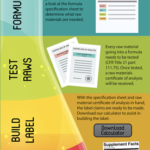When working with ingredients that typically measure potency with weight, i.e. mg, it can be difficult to understand the complexity of potency measured in “activity units.” Enzyme activity quantifies the amount of work the enzyme is doing. In the digestive process, we eat food and enzymes break the chemical bonds of the food substances creating a chemical reaction that can be measured– take a look!
Enzyme activity is not just listing the weight of the enzyme in the product, in fact it shows that the enzyme is active and is able to break down the food we consume—this is powerful information to have. Vitamins and minerals are labeled using mg as the potency value, but with enzymes, listing weight only shows that it is included in the product. It does not show the most important attribute—not only is the enzyme in the product, but it’s active and able to do work!
To measure the specific chemical reaction of enzymes, methods are set-up under very controlled conditions. Many of these methods come from the USP/FCC, British Pharmacopeia, Japanese Pharmacopeia, etc. These methods all have procedures for controlling the exact temperature, pH, time of the reaction and how results are calculated. There are also specific substrates (food to be broken down) for each method, so the reaction can be reproduced and different samples can be easily compared. This is ideal for comparing enzyme sample A to enzyme sample B. Moreover, it’s easy to see which raw material shows more activity, is more potent or if your finished product meets label claim.
Enzymes are categorized in groups depending on which bonds the enzyme can break, and there are different enzyme activity units because there are a variety of enzyme reactions that can be measured. Proteases break down proteins; lipases break down fats/lipids; lactase breaks down lactose; and amylase breaks down carbohydrates/starch, etc.
Each category is represented by different activity units. Proteases can be measured in HUT activity when measuring the reaction of breaking down hemoglobin. SAP activity for proteases is determined when showing the breakdown of casein at pH 3.0. Protease FCC PU activity can be measured when wanting to see the breakdown of casein in neutral pH 7.0. While these are just a few examples of how to measure protease activity, the resulting knowledge about multiple protease substrates and the optimal pH range is worth the testing investment that could pay off when marketing the finished product.
Thinking about potency in terms of “activity units” can be confusing, but testing gives you confidence, knowing that you are starting with a fully potent, raw material that is capable of producing a finished product that meets label claims. SORA Labs is your trusted partner when helping you navigate these complex test methods. Contact us for an enzyme testing quote today!






